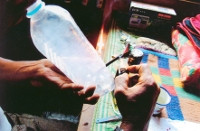The urgent next steps in ATS and Harm reduction Findings from a workshop in Burma/Myanmar
Topics
Now is the time to implement low cost and simple harm reduction measures for amphetamine-type stimulant users.

On October 13-14, 2011, the Burnet Institute and the Transnational Institute (TNI) organised an informal two-day workshop on Harm Reduction and ATS with the support of the Western Australian Substance Users Association (WASUA). The workshop took place in Yangon (Myanmar). The 35-40 participants included local representatives from drug user organisations and peer outreach workers from different regions of Myanmar, as well as international and local NGOs, and UN agencies in Myanmar.
The findings and recommendations of the workshop were summarized jointly by all participants in a short initial report that was presented to Yangon-based international donors, the embassies of different countries and NGOs working in the field at a reception at the end of the workshop. The information in the report is based on the informal presentations and discussions during the seminar.
Prior to the meeting, TNI published a Drug Policy Briefing outlining the issues at stake. Little is known about the methamphetamine market in the region. According to the United Nations Office on Drugs and Crime (UNODC), East and Southeast Asia have one of the most established methamphetamine markets in the world displacing traditionally plant-based drugs such as opium and heroin. There are strong indications that the situation is deteriorating: the substances are becoming stronger (from pills to crystal methamphetamine or ‘ice’) and methods of use are becoming more harmful (from swallowing pills to injecting), and the number of ATS users – especially among youth – keeps increasing.
Prevention, treatment as well as harm reduction strategies are in their initial phases. Services are still focused on injecting heroin users as the main problem and have little to offer for ATS users. ATS users rarely use harm reduction services, largely because they do not identify with opioid users, who often belong to different user networks. The needs of ATS users are usually neglected and few services are geared to their special needs. The earlier a comprehensive package of harm reduction measures for methamphetamine is introduced the better.
There are some promising indications in the region of a willingness to embark on new approaches, at least on paper. The Sub-Regional Action Plan on Drug Control 2011-2013 recognises that “while there are internationally tested drug prevention approaches and psychosocial interventions for ATS use and dependence, these have not yet been fully validated in Southeast Asia, where ATS use is on an upward trend and represents a majority of treatment demand in several countries in the region.” The Action Plan recognises the need to scale up public health oriented policies, as well as the need to develop alternatives to compulsory drug treatment/detention centres and implementation of community-based interventions based on prevention, early intervention, treatment and care programmes integrated in the health care system.
The WHO Regional Office for the Western Pacific recommends that “policy-makers must aim to reduce the harms from ineffective drug policies which allow for undifferentiated punishment and detention of all drug users, and find common ground between law enforcement and public health, thus enabling appropriate interventions to assist all ATS users.” The office published a series of four technical briefings laying out the latest available evidence on patterns and consequences of ATS use; harm reduction and brief intervention; guiding principles of prevention and treatment; and therapeutic interventions.
The urgent next step is to implement some low-cost and simple harm reduction measures for ATS users, which are outlined in the findings and recommendations of the workshop in Yangon.
